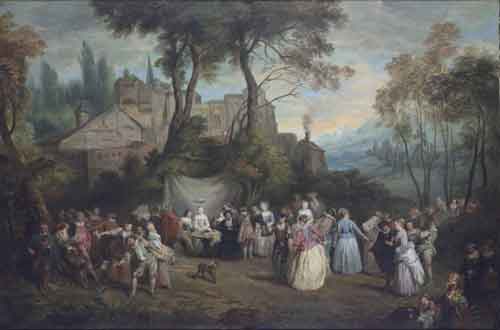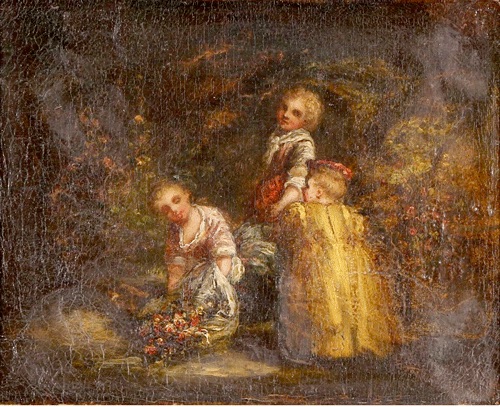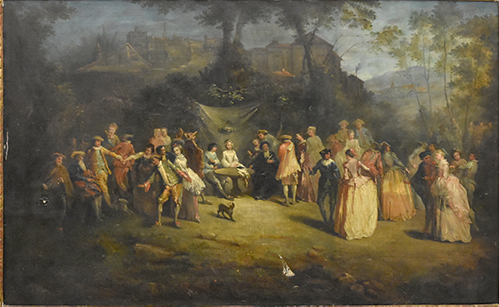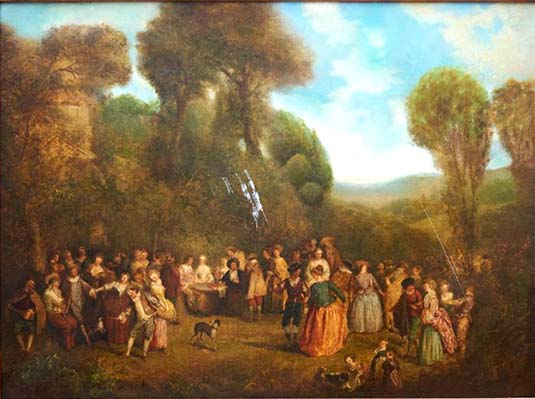
- Home Page
- Accepted
Paintings & Copies - Doubtful
Attributions - Doubtful Textual References
- Alternative
Titles - Collectors &
Museums - Bibliography
- Search Abecedario
- Watteau &
His Circle
L'Accordée de village (copy 1)
Entered March 2014; revised September 2016
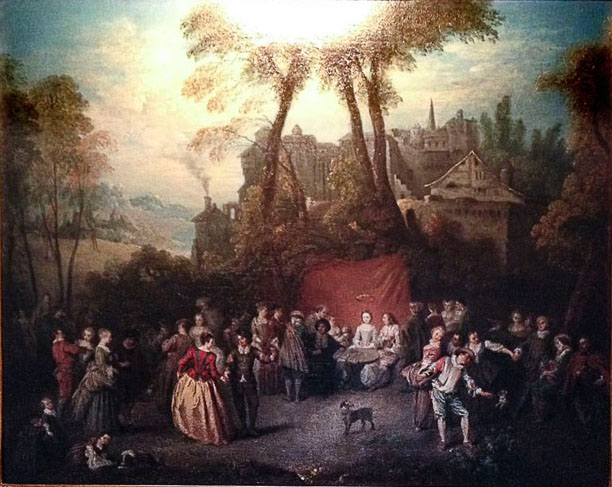
England, private collection
Oil on canvas
53.3 x 57.1 cm
ALTERNATIVE TITLES
Les Fiançailles au village
PROVENANCE
London, collection of Alfred de Rothschild (1842-1918). By descent to his son, Edmond de
Rothschild, and the picture has since remained with the family.
EXHIBITIONS
London, Royal Academy, Old Masters (1889), cat. 107 (as Watteau, L’Accordée du village, lent by Alfred de Rothschild).
SELECT BIBLIOGRAPHY
Davis, Description of the Collection of A. de Rothschild (1884), 1: cat. 75.
Villars, “Collection Rothschild” (1902), 15.
Zimmerman, Watteau (1912), 133.
Réau, “Watteau” (1928), under cat. 86.Adhémar, Watteau (1950), under cat. 130.
Macchia and Montagni, L’opera di Watteau (1968), under cat. 128.
REMARKS
Margaret Morgan Grasselli believes that the Rothschild picture was painted by Pater after Watteau's death (see her letter to Michael Hall, c. 1986, on file at the Sir John Soane's Museum).
L'Accordée de village (copy 2)
Entered March 2014; revised September 2016
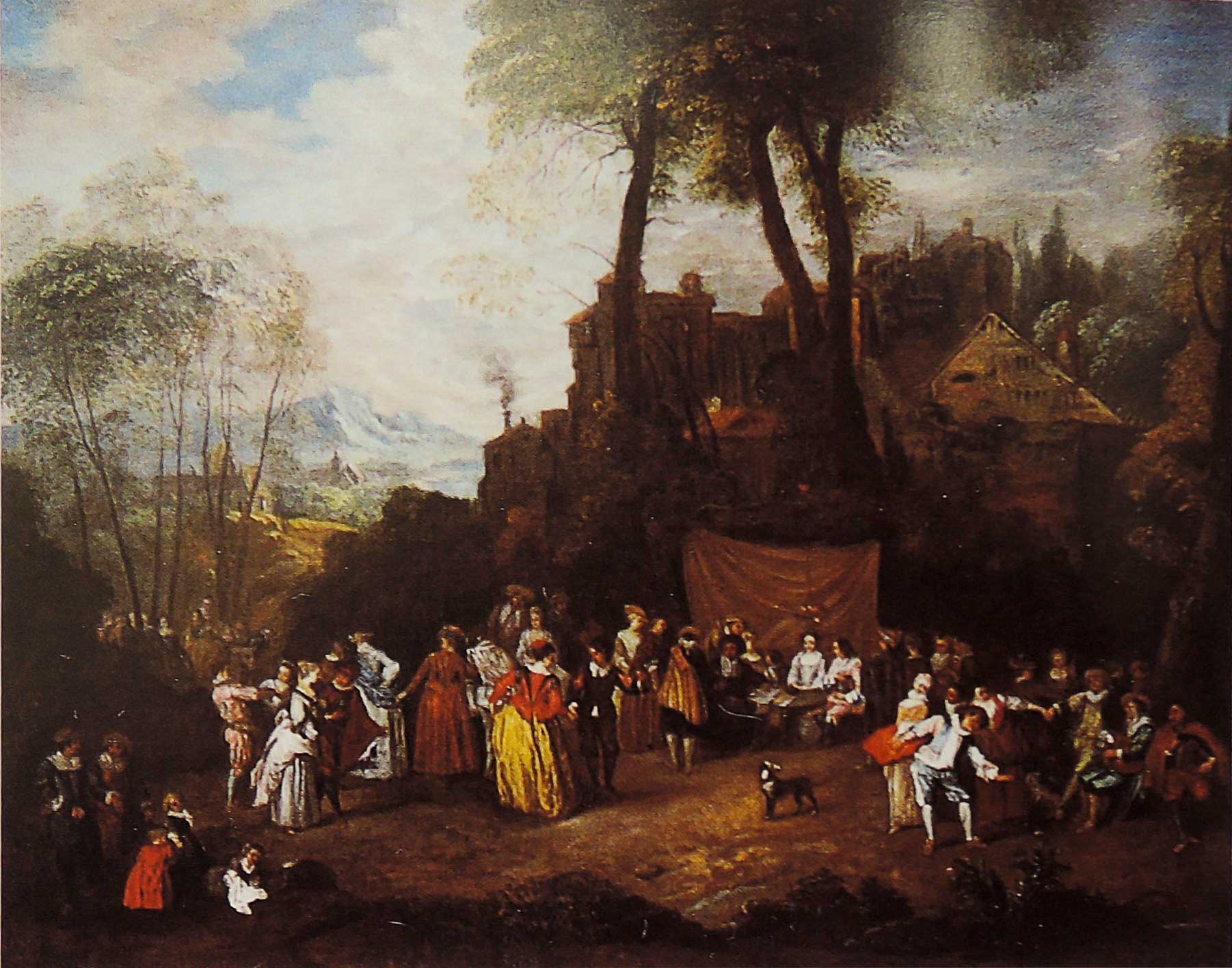
Whereabouts unknown
Oil on canvas
72 x 90.5 cm
ALTERNATIVE TITLES
Huldigung vor einer Prinzessin
The Marriage Contract
La Mariée de village
The Wedding Contract
PROVENANCE
Munich, collection of Adele Hagenmann; her sale, Frankfurt, Rudolf Bangel, Dec 7, 1891, lot 67: “PATER, Jean-Baptiste . . . Huldigung vor einer Prinzessin. Leinwand 73/91. (Siehe Abbildung)." The buyer’s name (Joh . . . [illegible]) and sale price of 1500 Marks appear in an annotated copy of the catalogue in the Rijksbureau voor Kunsthistorische Documentatie.
Sale, Cologne, October 27-29, 1904, collection of Bourgeois Frères, lot 101:”WATTEAU (ANTOINE) . . . L'Accordée de Village. L’Accordée, en costume de soie claire, occupe le milieu de la scène, un peu vers la droite du tableau; au-dessus de sa tête est suspendue une couronne de roses, près d’elle se tient son fiancé; tous deux sont assis auprès d’un petit guéridon; le groupe se détache sur un fond formé par un large tapis suspendu aux arbres.
A gauche du groupe, la mère qui jette sur la jeune fille un regard attristé; derrière elle, le père qui considère attentivement le jeune homme; en avant de ce second groupe et le masquant en partie, le notaire portant les insignes de ses fonctions, il tend la plume à l’un des parents pour signer le contrat qui est posé devant lui. De chaque côté sont harmonieusement groupés des couples d’invités, la plupart en costumes de soie claire, les uns s’entretenant galamment, d’autres s’apprêtant à danser; près de ces derniers sont assis deux musiciens. On voit monter en grand nombre à gauche du fond de la vallée des invités et des curieux.
La scène se passe en plein air à l’ombre de deux grands arbres et à proximité d’un village situé à flanc de côteau. A gauche, vallée ensoleillée, limitée par de faibles collines. A travers de jeunes peupliers apparaîssent des maisons, une église etc. La masse sombre du château qui domine le village contraste heureusement avec cette partie claire du tableau.
Toile. Haut. 71—Larg. 91 cent.
Ce célèbre tableau de l'artiste français a été reproduit en gravure par Nicolas de Larmessin, professeur de Frédéric Schmidt, graveur de la cour de Berlin; Larmessin le signale comme appartenant au «Cabinet de Mr de Julienne » et le désigne sous le titre de « L'Accordée de village ». La gravure (Andresen, Handbuch f. Kupferstich-Sammler N. 13) est jointe au tableau.
Le tableau a été acheté par Monsieur Stéphan Bourgeois à un prince autrichien. Il provenait par cadeau ou par achat de la marquise Sophie Frédérique Wilhelmine de Bayreuth, sœur de Frédéric le Grand. D’après une vieille tradition l’œuvre de Watteau fut achetée pour le compte de Frédéric II roi de Prusse qui voulait l’offrir à sa sœur préférée. On trouve une copie du tableau (probablement par Pater) au château de Potsdam (V. E. Hannover, A. Watteau, Berlin 1889, page 104).
Plusieurs tableaux du maître français appartenant au roi de Prusse, se trouvaient en possession de son intime ami Jean de Julienne, entre autres le célèbre « Embarquement pour Cythère » qu'on n'a connu pendant très longtemps que par la belle gravure de N. H. Tardieu (Andresen, ouvrage cité N. 10 et Hannover o. c. p. 48).
E. de Goncourt (L'Oeuvre d’Antoine Watteau. Paris 1875) et P. Mantz (A. Watteau. Paris 1892) ne connaissent l’un et l’autre que la gravure de N. de Larmessin, mais non l’original. Tous les deux considèrent le tableau de Madrid comme une première esquisse de l’œuvre dont ils avaient la gravure. Mantz dit expressément o. c. p. 187: « Le tableau qui représente les préparatifs d'une noce, rappelle la composition de « l’Accordée dé Village » gravée par N. de Larmessin, et c'est peut-être comme l’indique E. de Goncourt, la première pensée du tableau définitif.»The claim by Bourgeois Frères that this picture once belonged to Wilhelmine, Margravine of Bayreuth (1709-1758), and was purchased for her by her brother, Frederick II of Prussia, is undoubtedly spurious. So too their claim that they had bought it from an Austrian prince, since the painting came, after all, from the private collection of Adele Hagenmann of Munich.
Paris, Hôtel Drouot, May 24, 1923, lot 7: “BAR (Bonaventure de) (Attribué à) . . . La mariée de Village. Peinture d’après A. WATTEAU. Toile. Haut., 70 cent.; larg., 89 cent.”
Paris, Galerie Nardus et Bourgeois. Its sale, Paris, Hôtel Drouot, May 30, 1924, lot 42: “WATTEAU (Atelier d’Antoine) . . . L’accordée de village. Gravé par Larmessin. Cadre Louis XV en bois sculpté et doré. Toile. Haut., 0m 75; 0m 90.”
London, Walter J. Abraham collection. Sold London, Christie’s, July 28, 1933, lot 32: ”BONAVENTURE DEBAR . . . THE MARRIAGE CONTRACT / 28 in. by 35 in.” According to the annotated copy of the catalogue in the Metropolitan Museum of Art, the painting sold to Thomson for £78.15.
London, Palser Gallery, 1933, as Bonaventure de Bar.
Paris, Hôtel Drouot (Lombrail & Teucquam), May 12, 2000, lot 68: “Entourage de Jean-Baptiste PATER . . . Le contrat de mariage. Toile. 72 x 90.5 cm (restaurations) Voir la reproduction en couleurs.”
SELECT BIBLIOGRAPHY
Hannover, Watteau (1888), 104.
Revue de l’art ancien et moderne, 15 (1904), 231.
Petrucci, “French Exhibition” (1904), 217-19.
Zimmerman, Watteau (1912), 181, under no. 133.
Ingersoll-Smouse, Pater (1928), cat. 596.
Adhémar, Watteau (1950), under cat. 130, 256.
Macchia and Montagni, L’opera completa di Watteau (1968), under cat. 127.
Eidelberg, "De Bar" (2011-13) 2: cat X. 13.
REMARKS
Ingersoll-Smouse accepted this work as a copy by Pater after Watteau’s composition, and was echoed by Adhémar. The painting does not seem to support this attribution, however. Adhémar also claimed that this painting was the one in the Jullienne collection that was engraved by Larmessin. She thought that certain features of the painting—such as the shapes of the trees—corresponded more closely to the model followed by Larmessin. Macchia and Montagni present this picture and the one discussed by Ingersoll-Smouse as two separate copies. The title of the Hagenmann picture should be translated as “Paying Homage before a Princess,” not “Un Mariage de village,” as Ingersoll-Smouse stated.
L'Accordée de village (copy 3)
Entered March 2014; revised July 2019
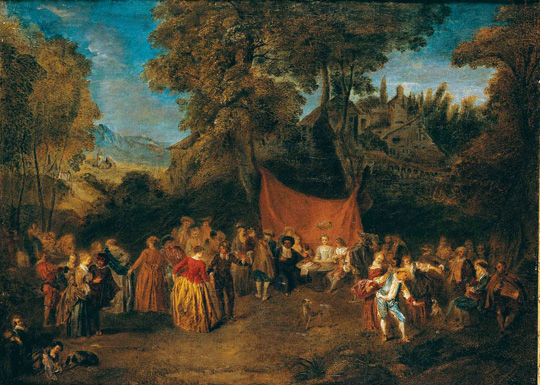
Paris (?), private collection
Oil on canvas
60.5 x 84.5 cm
ALTERNATIVE TITLES
The Marriage Contract
The Rural Wedding
PROVENANCE
London, collection of Henry Fowler Broadwood (1811-1893; piano manufacturer) before 1892. Broadwood’s ownership was cited by René Gimpel on Nov 11, 1927, while reviewing his father’s earlier business records. His sale and others, London, Christie’s, March 25, 1899, lot 58: “A. WATTEAU . . . L’ACCORDÉE DU VILLAGE: In the centre of the picture the bride and bridegroom are seated beneath some high trees, in front of a red cloth, with a crown suspended over the bride; on a table before them, at which a lawyer sits, with pen in hand, is the marriage contract; a number of people are grouped round them, some of whom are dancing; two men are playing instruments on the right; various farm buildings on high ground, behind the trees; village church and cottages, on the left 22 ½ in. by 81 in. Exhibited at Burlington House, 1892.” Sold for £1312.10.0 to Gibbs (an agent for Agnew’s) according to the annotated copy of the sale catalogue in the Rijksbureau voor Kunsthistorische Documentatie.
London, Thomas Agnew and Sons until March 8, 1900, when the firm sold it to T. Humphrey Ward (1845-1926) (according to Agnew’s stock book, no. 8846, as cited by Selby Whittingham). This provenance was also noted by René Gimpel on November 11, 1927, while reviewing his father’s business records.
Paris, collection of Ernest Gimpel, who sold it to Ernest Crosnier on March 22, 1901, for 141,000 francs, not 191,000 francs as stated in the published version of René Gimpel’s diary. (I am grateful to Diana Kostyrko for this and other information regarding Gimpel’s ownership of this painting.)
Paris, collection of Ernest Crosnier (d. 1905).
Paris, collection of Ernest Gimpel; acquired from Crosnier on June 5, 1903, according to Diana Kostyrko.
Paris, E. Gimpel and Wildenstein, acquired October 15, 1905, per the Wildenstein archives; transferred to the firm’s New York branch in October 1912.
Cleveland, collection of Francis F. Prentiss (1858-1937; industrialist) and Elisabeth Severance Prentiss (1865-1944, heiress), purchased between 1919 and 1923. Seen by René Gimpel in the Prentiss residence in May 1923. Bequeathed by Mrs. Prentiss to the Cleveland Museum of Art in 1944; inv. no. 44.94. Deaccessioned in 1964.
New York, Hirschl & Adler.
New York, Sotheby Parke Bernet, November 28, 1978, lot 174: “BONAVENTURE DE BAR. . . THE MARRIAGE CONTRACT. . . Elegant couples strolling, conversing and dancing in a pastoral setting, the betrothed couple sit with a clergyman in a bower beyond, a town on a hill in the distance/ 23 x 31½ inches / 58.5 x 80 cm.”
Hawaii, collection of Robert Louthbridge.
New York, Sotheby Parke Bernet, January 20, 1983, lot 2: “. . . BONAVENTURA [sic] DE BAR. . . THE MARRIAGE CONTRACT. . . Oil on canvas. . . 23 x 31½ inches. . . 58.5 x 80 cm.” Bought by Harari & Johns, Ltd.
London, Harari & Johns, Ltd.
Paris, Galerie Segoura.
Paris, sale, Hôtel Drouot (Tajan), June 20, 2007, lot 26: “ANTOINE WATTEAU. . . L'ACCORDÉE DU VILLAGE Toile 60.5 x 84.5 cm Restaurations anciennes 200 000 / 300 000€ Provenance: Probablement dans la collection de Lord Battersea jusqu’en 1820; Collection Henry Broadwood avant 1899; Sa vente, Christie’s, Londres, 25 mars 1899, no 58 (acquis par Gibbs pour la galerie Agnew’s); Galerie Agnew’s, Londres, jusqu’en 1900; Collection T. Humphrey Ward (1845-1926), jusqu’en 1901; Collection Ernest Cronier jusqu’en 1903; Collection René Gimpel de 1903 à 1919; Collection de Mrs. Francis F. Prentiss, Cleveland, probablement vers 1919 jusqu’en 1944; Cleveland Museum of Art de 1944 à 1964; Galerie Hirschl & Adler, New York (Selon Selby Whittingham, voir son article “Watteaus and “Watteaus” in Britain c. 1750-1851”, in Antoine Watteau, op. infr.); Collection Robert Loughbridge (Selon Selby Whittingham, idem); Vente Sotheby Parke Bernet, New York, 20 janvier 1983, no 2 (Bonaventure de Bar); Acquis à cette vente par la galerie Harari & Johns, London, 1984.
. . . Par le choix de son sujet et son style, notre tableau illustre parfaitement l’originalité de l’œuvre de Watteau. Entre fête et scène champêtre, l'Accordée de Village s'inscrit dans le thème des fêtes de plein air apparu dès la fin du XVIIe siècle. Cependant, Watteau aborde le genre avec un esprit différent, tout en finesse et virtuosité: à la reine de la fête audacieusement décentrée vers la gauche - sa présence est ainsi paradoxalement amoindrie et soulignée - Watteau ajoute une foule occupée à elle-même, à jouer, danser ou converser fidèle ainsi à la tradition brueghelienne. A cette iconographie flamande, il mêle un raffinement des attitudes et un traitement mordoré des tissus issu de la grande tradition picturale vénitienne, créant ainsi un monde énigmatique et empreint de poésie. Le thème de l‘Accordée de Village est récurrent chez Watteau. Trois autres versions sont aujourd’hui recensées, le tableau du John Soane’s Museum à Londres (toile, 63 x 92 cm), celui conservé à Berlin au Château de Charlottenbourg (toile, 65 x 92 cm) présentant de nombreuses variantes et enfin, un tableau conservé autrefois dans les collections d’Alfred de Rothschild, aujourd’hui non localisé, parfois considéré comme une copie. Comme dans le tableau conservé à Londres, Watteau reprend la composition du Contrat (toile, 47 x 55 cm, conservée au Prado à Madrid) en l’élargissant considérablement en particulier à gauche et en remplaçant les arbres du fond par un groupe de maisons. La construction de notre scène est bordée avec rigueur par deux hommes à droite et deux enfants à gauche. Ce thème traité ainsi chez Watteau a bénéficié d’un grand succès, popularisé par d’innombrables copies de ses modèles.” Sold for €402,036 to an American collector. Subsequently the painting was returned to the auctioneer on the basis that the painting was not by Watteau. After a legal process the buyer was awarded back his purchase price.
EXHIBITIONS
London, Royal Academy, Old Masters (1892), cat. 43 (by Watteau, L'Accordée de village, lent by H. F. Broadwood).
Brussels, L’Exposition de l’art français (1904), cat. 77 (by Watteau, L’Accordée de village, lent by Lord Battersea).
Paris, Château de Bagatelle, Les Modes (1911), cat. 168 (by Watteau, L’Accordée de village, lent by M. Wildenstein).
Cleveland, Museum, Elisabeth Severance Prentiss Collection (1944), cat. 16 (by Watteau, The Rural Wedding, L'Accordée de Village).
Tokyo, Gallery Ida, French Painting (1988), cat. 7 (by Watteau, L’Accordée de village, with Harrari & Johns).
SELECT BIBLIOGRAPHY
Pêne du Bois, “Revived Interest in French Art” (1913), 96.
Adhémar, Watteau (1950), under cat. 130.
Gimpel, Journal (1963) 111, 236, 309-10.
Whittingham, “Watteaus and ‘Watteaus’” (1987), 273-74.
Glorieux, Watteau (2011), 187, 190.
Eidelberg, “De Bar” (2011-13), 2: cat. X. 9.
REMARKS
The 2007 Drouot auction catalogue suggests that at some point prior to 1820 Lord Battersea probably owned the painting. However, Cyril Flower, first Baron of Battersea (1843-1907), could not have owned the picture before 1820 since he was not born until some twenty years later. There is no indication that he ever owned it. In 1877 Cyril Flower married Constance Rothschild (1843-1931), the eldest daughter of Sir Anthony Nathan de Rothschild. A version of L’Accordée de village (our copy 1) was owned by Alfred de Rothschild and his family in the nineteenth century. Could this family link somehow underlie the dubious provenance cited in the 2007 Drouot catalogue? A letter dated May 10, 1983, from Derek Johns of Harari & Johns to Pierre Rosenberg, claims that Battersea owned the painting in 1904 when it was exhibited in Brussels.
In the early twentieth century, the painting enjoyed an attribution to Watteau, but then, while it was at the Cleveland Museum, the attribution was downgraded to school of Watteau. Adhémar, who accepted no less than four versions as originals, even claimed that this one was better preserved than the Soane picture. But given her lack of any reference to where it actually was, she may have based her opinion on a photograph. In fact, the surface of the painting seems extremely thin in many places. It was cleaned in 1984, but this did not alleviate the problem.
When the painting was auctioned in 1983, it bore an ascription to Bonaventure de Bar. The London dealers Harari & Johns then returned the attribution to Watteau. For the last quarter century that claim has continued to be made by dealers and auction houses, but except for Whittingham and Glorieux, scholars have not even considered this version of the composition. Glorieux blames the poor appearance of the work on Watteau’s improper painting technique which caused the figures to deteriorate. He sees evidence of Watteau’s hand in the dancing couple and the couple that enter from the left. But even those figures show nothing that approaches the level of Watteau’s work. While the copyist often but not consistently imitated the color of the original painting, suggesting that he had the Soane picture (or perhaps the Rothschild version?) as a model, this work is a very weak shadow of Watteau’s original. Also, it lacks the figures in the lower left of the original composition.
Although Adhémar lists this picture as having passed through the December 20, 1918, sale at Christie’s, the Watteau painting in that sale (lot 143) was a copy after La Mariée de village. Furthermore, although Adhémar lists Gibbs as the buyer at the 1918 sale, he was actually the buyer at the 1899 sale, as listed above. As always, these errors were repeated by Macchia and Montagni.
L'Accordée de village (copy 4)
Entered March 2014; revised September 2016
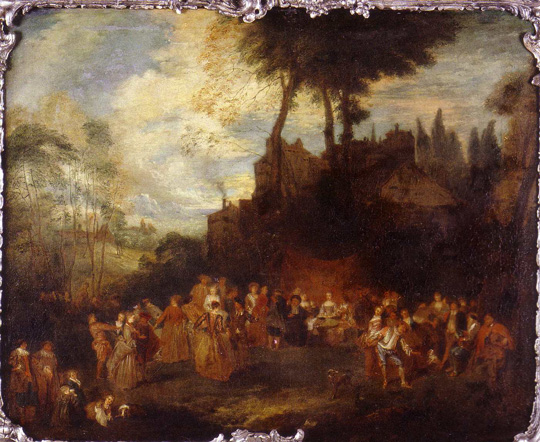
Berlin, Schloss Charlottenburg
Oil on canvas
72.5 x 91 cm
ALTERNATIVE TITLES
Gesellschaft am Fuss eines Berges (A Company of People Beneath a Mountain)
PROVENANCE
Rheinsberg, Schloss, collection of Frederick II [Frederick the Great] (1712-1786; king of Prussia).
Berlin, Stadtschloss, 1745-1942.
Berlin, Schloss Charlottenburg, inv. GK I 4183.
EXHIBITIONS
Berlin, Schloss Charlottenburg, Meisterwerke (1962), cat. 101 (as Watteau, Gesellschaft am Fuss eines Berges).
SELECT BIBLIOGRAPHY
Hannover, Watteau (1888), 104.
Vogtherr, Französische Gemälde (2011), 227-32.
REMARKS
Given the great number of copies made after Watteau’s L’Accordée de village and the uncertainties about their origin and date, this picture is particularly useful since it is documented to be a product of a Paris studio before 1740. The direction of the composition and the colors of the costumes suggest that this version was copied from Watteau’s original canvas or a close replica.
The 1962 exhibition claimed that the picture was in the dining room of the Potsdam city palace by 1733, but the more recent and exacting study by Voghtherr and his colleagues does not trace the painting further back than 1740.
L'Accordée de village (copy 5)
Entered March 2014; revised September 2016
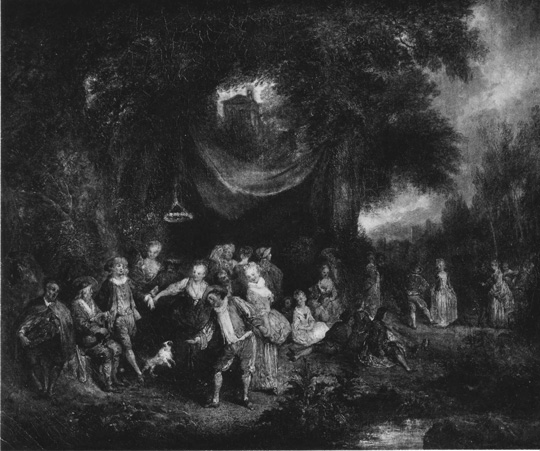
Whereabouts unknown
Oil on canvas
46 x 55 cm
ALTERNATIVE TITLES
Fête champêtre
La Noce villageoise
PROVENANCE
Paris, Lafontaine collection. This provenance appears in the 1895 exhibition catalogue issued by the Sedelmeyer Gallery as cited below, but without any time frame or more specific identity for Lafontaine. Unfortunately, the family name relatively common and therefore difficult to trace. For example, the London sale of “Mons. Lafontaine” on May 7, 1824, contained two paintings ascribed to Watteau: lot 15, A Garden Scene, and lot 27, A View in the Park of Versailles. Either of these titles could be used to describe L’Accordée de village.
Paris, A. Leveau; bought from(?) Leveau April 17, 1894, for 17,500 francs. This provenance appears on an annotated page (annotated by Sedelmeyer?) from the 1895 Sedelmeyer catalogue on file at the Service de documentation, Louvre, Département des peintures.
Paris, collection of Albert Lehmann (d. 1922), purchased May 1894 for 27,000 francs from Sedelmeyer. This information appears on the annotated page from the 1895 Sedelmeyer catalogue on file at the Service de documentation, Louvre, Département des peintures.
Paris, sale of the collection of Albert Lehmann, Galerie Georges Petit, June 8, 1925, cat. 223: “WATTEAU (Attribué à JEAN-ANTOINE). . . La Noce villageoise. Une colline boisée domine, à gauche, une prairie que foulent les pas des danseurs. L’un d’eux, de gris et de lilas vêtu, agace un chien sans interrompre la figure commencée. Deux musiciens, un joueur de vielle et un joueur de musette les accompagnent. Des groups, assis sur l’herbe, devisent, au centre, près d’une tente suspendue aux branchages de grands arbres. A droite, d’autres personages. Toile. Haut., 46 cent.; larg., 55 cent. Collection La Fontaine. Reproduit dans la Sedelmeyer galerie (Second hundred, 1895, p. 86, no 72, fig.). Cadre en bois sculpté. Voir la reproduction.” According to an annotated copy of the catalogue in the Metropolitan Museum of Art, the painting sold to Edouard Jonas for 45,100 francs.
Paris, collection of Edouard Jonas (1883-1961).
EXHIBITIONS
Paris, Galerie Sedelmeyer, Second Series of 100 Paintings by Old Masters (1895), cat. 72 (as by Watteau, Fête Champêtre, lender not identified).
SELECT BIBLIOGRAPHY
Adhémar, Watteau (1950), under cat. 130.
Macchia and Montagni, L’opera completa di Watteau (1968), under cat. 127.
REMARKS
Although listed by Adhémar as a “reduced copy” of L'Accordée de village, and followed in this by Macchia and Montagni, in truth, the painting is more of a pastiche. Only the figures in the left foreground, as well as the canopy, the suspended crown of flowers, and the couple at the extreme right, imitate elements in L’Accordée. The remaining figures derive from other sources in Watteau. Those in the central middle ground were taken from Le Bal champêtre, while the dancing couple farther to the right can be traced to La Danse paysanne.
There is a discrepancy regarding the two measurements of the painting’s width. When it was exhibited by Sedelmeyer, the width was listed as 21½ inches (31.7 cm). But the 1925 Lehmann sale recorded the width as 55 cm. The proportions shown in the photograph establish that the larger size is correct.
![]()
L'Accordée de village (copy 6)
Entered March 2014; revised July 2019

Whereabouts unknown
Oil on canvas
Measurements unknown
PROVENANCE
Paris, collection of Auguste Stevens (chevalier de l'ordre d'Isabelle la Catholique). His sale, March 1-4, 1847, lot 318: “WATTEAU . . . La Mariée de village, pendant du précédent. Au milieu d’une nombreuse société , le jeune couple, précédée des parents et d’une troupe de musiciennes, se dirige vers un teniple; le cortége est suivi par une foule de curieux de toutes conditions qui se trouvent sur le passage. Il serait fort long d’énumérer toutes les figures de ces deux importantes compositions, et encore plus de décrire les actions de chacun: nous nous bornerons à dire qu’ils offrent l’image fidèle des fêtes villlageoises que l’on représentai sur le théâtres à cette époque. . . . ."
SELECT BIBLIOGRAPHY
Réau, “Watteau” (1928), under cat. 86.
Adhémar, Watteau (1950), under cat. 130.
Macchia and Montagni, L’opera completa di Watteau (1968), under cat. 127.
REMARKS
The painting was sold with a pendant, a copy after Watteau's Mariée de village. The measurements of the two canvases are not given, but they were apparently substantial. The entry for the pendant states: “Deux ouvrages en tapisserie, des mêmes sujet et grandeur, existent dans la collection du duc de Devonshire, en Angleterre, raison pour laquelle Watteau les a peints de cette grandeur extraordinaire.”
L'Accordée de village (copy 7)
Entered March 2014; revised Septemer 2016
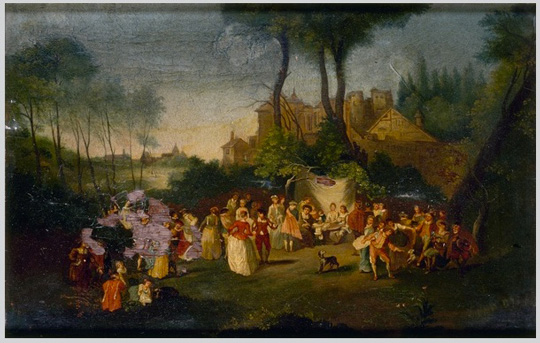
Nantes, Musée des beaux-arts, inv. 739.
Oil on panel
25.5 x 39.4 cm
ALTERNATIVE TITLES
Danse paysanne
PROVENANCE
Nantes (?), collection of M. de Corseul; bequeathed by him to the Musée de beaux-arts de Nantes in 1896.
SELECT BIBLIOGRAPHY
Nicolle and Dacier, Catalogue (1913), cat. 739.
Gerin-Pierre, Catalogue des peintures françaises (2006), cat. 228.
REMARKS
When this painting was catalogued for the first time in 1913, it was called simply “Danse Paysanne” and was attributed to an “Imitateur de Watteau.” It is now rightly acknowledged to be just a copy after L’Accordée de village. Gerin-Pierre listed it questioningly as an eighteenth-century work, although at the same time she attributed it to a nineteenth-century copyist.
L'Accordée de village (copy 8)
Entered March 2014; revised July 2014
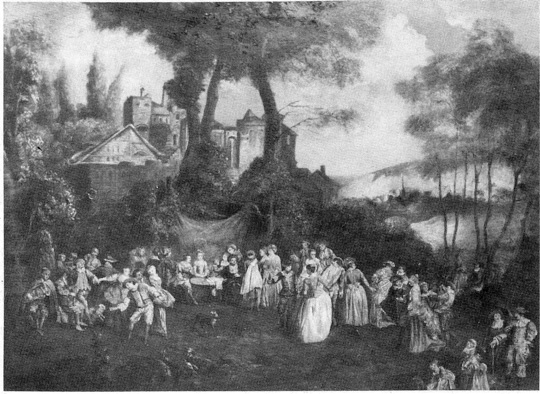
Whereabouts unknown
Oil on panel
55 x 75 cm
ALTERNATIVE TITLES
La Fête champêtre
PROVENANCE
Paris, sale, Palais Galliera, November 27, 1975, lot 22: “SUITE DE QUILLARD . . . La fête champêtre. Panneau. Haut. 0,55 m Larg. 0,75 m.”
REMARKS
This painting bears no relationship to Quillard’s work. It is just an anonymous copy of the Larmessin engraving after L’Accordée de village.
L'Accordée de village (copy 9)
Entered March 2014; revised March 2019
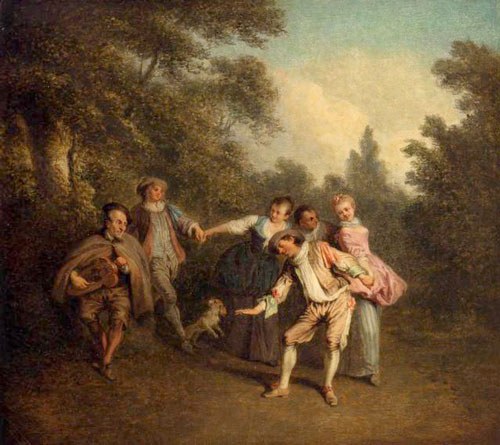
Whereabouts unknown
Oil on canvas
24.8 x 27.9 cm
ALTERNATIVE TITLES
Scene from the Village Wedding
PROVENANCE
London, Thomas Agnew and Sons, c. 1921, as “School of Pater” (according to annotations on the verso of a photograph in the Frick Art Reference Library, New York).
New York, collection of Albert John Kobler (newspaper publisher and real estate developer). Sale, New York, Parke-Bernet, April 22, 1948, lot 15: “BONAVENTURE DE BAR. . . SCENES FROM THE VILLAGE WEDDING AFTER WATTEAU: PAIR PAINTINGS. Pastoral scenes in verdant landscapes , with groups of youths and maidens dancing, in one scene accompanied by a spaniel with an old man playing a hand organ. (Kobler). . . Note: The above groups are similar to groups in the famous painting by Watteau. L’Accordée de Village (Soane Museum, London), but in reverse. See E. Heinrich Zimmerman, Des Meisters Werke, Klassiker der Kunst, 1912, p. 19.” According to the annotated copy of the catalogue in the Metropolitan Museum of Art, New York, the pair of paintings sold for $1000.
New York, collection of Mary Kettaneh (1914-2016). Her sale and others. New York, Doyle’s, May 25, 2017, lot 76: “School of Jean-Baptiste Pater, Couples Dancing in a Park, with a Hurdy-Gurdy Player and a Dog / Oil on canvas / 9¾ x 11 inches (24.7 x 28 cm) / Estimate $1,500 - $3,000.” Sold for $3,750.
SELECT BIBLIOGRAPHY
Eidelberg, “De Bar” (2011-13), 2: cat. X. 14.
REMARKS
This painting bears no relationship to the work of Pater or Bonaventure de Bar. Rather it excerpts the figures from the left side of Larmessin’s engraving after L’Accordée de Village. It has a pendant (our copy 10) that replicates the figures from the other side of the engraving.
L'Accordée de village (copy 10)
Entered March 2014; revised September 2016
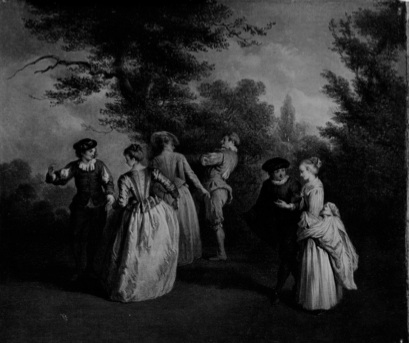
Whereabouts unknown
Oil on canvas
24.8 x 27.9 cm
ALTERNATIVE TITLES
Danse champêtre
Scene from the Village Wedding
PROVENANCE
London, Thomas Agnew and Sons, c. 1921, as “School of Pater” (according to annotations on the verso of a photograph in the Frick Art Reference Library, New York).
New York, collection of Albert John Kobler (newspaper publisher and real estate developer). Sale, New York, Parke-Bernet, April 22, 1948, lot 15: “BONAVENTURE DE BAR. . .” SCENES FROM THE VILLAGE WEDDING AFTER WATTEAU: PAIR PAINTINGS. Pastoral scenes in verdant landscapes, with groups of youths and maidens dancing (Kobler) . . . Note: The above groups are similar to groups in the famous painting by Watteau. L’Accordée de Village (Soane Museum, London), but in reverse. See E. Heinrich Zimmerman, Watteau, Des Meisters Werke, Klassiker der Kunst, 1912, p. 19.” According to the annotated copy of the catalogue in the Metropolitan Museum of Art, New York, the pair of paintings sold for $1000.
SELECT BIBLIOGRAPHY
Ferré, Watteau (1972), cat. P47.
Eidelberg, “De Bar” (2011-13), 2: cat. X. 15.
REMARKS
Like copy 9, this painting has no connection to Pater or Bonaventure de Bar. Its figures are excerpted from the right side of Larmessin’s engraving after L’Accordée de Village. It also rearranges their sequence. Its pendant duplicates the figures from the other side of the engraving.
L'Accordée de village (copy 11)
Entered March 2014; revised June 2015
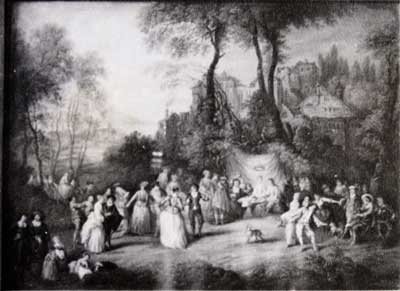
Whereabouts unknown
Oil on canvas
30.5 x 35.5 cm
PROVENANCE
Collection of the Earl of Malmesbury.
Collection of Olivier Robin Bagot (1914-2000), Levens Hall, Westmorland.
L'Accordée de village (copy 12)
Entered March 2014; revised September 2016
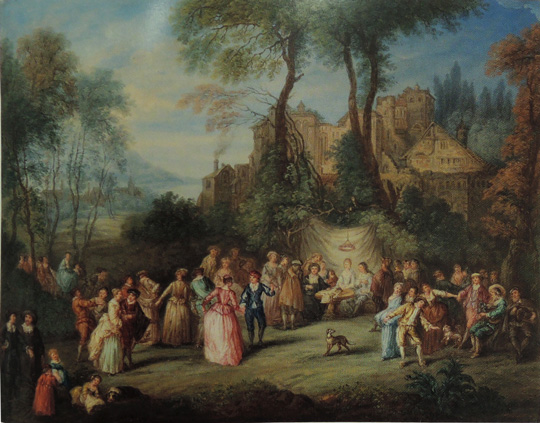
Whereabouts unknown
Oil on panel
25.4 x 33.6 cm
ALTERNATIVE TITLES
A Fête Galante in a Landscape
PROVENANCE
London, Christie’s, February 9, 1979, “property of a lady,” lot 148: “BONAVENTURE DE BAR (After WATTEAU) . . . L’ACCORDEE DE VILLAGE / on panel / 10 x 13 ¼ in. (25.4 x 33.6 cm) / EXHIBITED: Aberystwyth, The National Library of Wales, on loan / Plate 42.”
London, Sotheby’s Olympia, April 24, 2007, lot 525 (“property of a Gentleman of Title”): “FOLLOWER OF JEAN-ANTOINE WATTEAU, A FÊTE GALANTE IN A LANDSCAPE BELOW A HILLTOP TOWN / oil on panel / 25.5 by 35 cm.; 10 by 13 ¾ in. The painting has a traditional attribution to Hendrick de Meyer (1737-1793). PROVENANCE Purchased by the present owner in 1969. £4,000-6,000 / €5,900-8,900 / US$7,800-11,600.” Sold for £7,800.
SELECT BIBLIOGRAPHY
Eidelberg, “De Bar” (2011-13): 2: cat. X. 8.
REMARKS
Despite the shift in attribution in the two London sales, the work's appearance, size, and panel support, as well as the allusion to a titled owner, seem sufficiently close to suggest that the two sales were of the same work. The picture should not be assigned to Bonaventure de Bar but to an anonymous copyist. Fittingly, in 1979 the picture was paired with an anonymous copy after Watteau’s Les Plaisirs du bal.
L'Accordée de village (copy 13)
Entered March 2014; revised July 2014
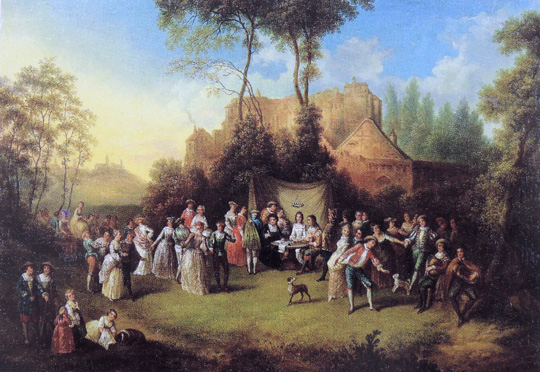
Whereabouts unknown
Oil on canvas
62.5 x 91.4 cm
ALTERNATIVE TITLES
Matrimonio con festa galante (A Wedding with a Fête Galante)
PROVENANCE
Rome, Christie’s, December 6, 2001, lot 280: “CERCHIA DI BONAVENTURE DE BAR / Matrimonio con festa galante all’aperto / olio su tela / cm 62,5 x 91,5 / Stima Lit. 25,000,000-30,000,000 US $12,000-14,000 / €13,000-15,000.” Sold for 24,500,000 lira (US $11,295).
SELECT BIBLIOGRAPHY
Eidelberg, “De Bar” (2011-13), 2: cat. X. 10.
REMARKS
This picture has no relation to the work of de Bar and his circle, and is simply an anonymous copy after Watteau’s Accordée de village.
L'Accordée de village (copy 14)
Entered March 2014; revised September 2016
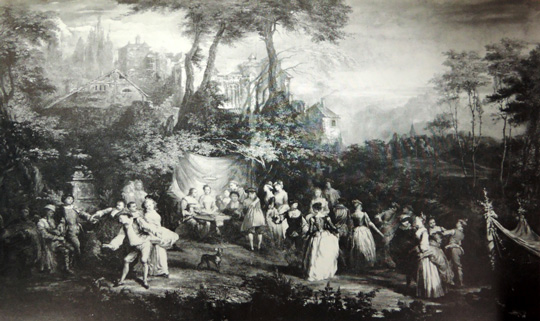
Whereabouts unknown
Oil on canvas
65 x 98 cm
ALTERNATIVE TITLES
The Marriage Contract
PROVENANCE
London, Christie’s, April 1, 1966, "property of a lady," lot 70: “BONAVENTURA [sic] DE BAR. . . . THE MARRIAGE CONTRACT; a gathering of elegant figures in a wooded landscape with, in the centre, the lawyer seated at a table with the contract papers, and other figures dancing to the left—signed with monogram—26 in. by 38½ in. / See illustration.”
London, Sir Richard Ford collection.
London, Christie’s, December 13, 1974, lot 117: “BONAVENTURE DE BAR . . . THE MARRIAGE CONTRACT / 26 x 39 in. (66.04 x 99.06cm.) / PROVENANCE: Sir Richard Ford, London / See Plate 18.”
Collection of Earl Spring; sale, New York, Sotheby Parke Bernet, June 7, 1978, lot 154:"BONAVENTURE DE BAR . . . THE MARRIAGE CONTRACT / Elegant couples dance in a pastoral setting to the music of a piper, in a bower beyond the betrothed couple sits with a clergyman, a town in the distance / 25½ x 38 ½ inches / 65 x 98 cm./ Provenance: Sir Richard Ford, London / [See illustration].”
SELECT BIBLIOGRAPHY
Eidelberg, “De Bar” (2011-13), 2: cat. X. 11.
REMARKS
This picture is unrelated to the work of de Bar and his circle. It is merely an anonymous variation upon Larmessin's engraving after Watteau’s L’Accordée de village. The composition has been turned into a more horizontal frieze with the figures closer to the picture plane, and an urn on a plinth has been added at the left to give weight to that area. Similarly, a tent now appears at the far right. Likewise, the background curtain of trees has been solidified and the view into the distance is closed off. All these changes reduce the airy quality of Watteau’s composition. Also, there are some changes among the figures: most notably, the two men and children formerly in the left corner of Watteau’s painting have been omitted.
Despite the supposed presence of a monogram of Bonaventure de Bar when sold in 1966, the picture is not by him. Moreover, he never signed or monogrammed his pictures. No monogram is mentioned in the subsequent two sales.
L'Accordée de village (copy 15)
Entered March 2014; revised October 2018
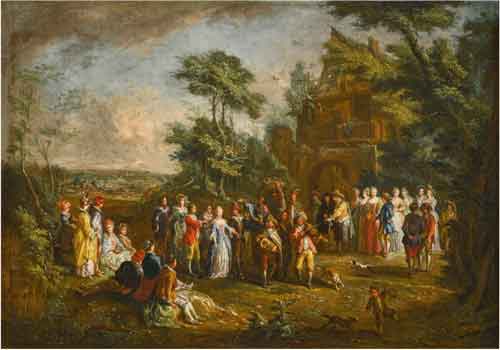
Whereabouts unknown
Oil on canvas
45.6 x 63.2 cm
ALTERNATIVE TITLES
La Mariée de village
The Marriage Contract
PROVENANCE
Paris, with the dealer George Aubry, c. 1928; presented as a work by Bonaventure de Bar.
London, Sotheby’s, sale, May 2, 2018, lot 64: “FOLLOWER OF JEAN-ANTOINE WATTEAU / The Marriage Contract; The Village Bride / a pair, both oil on canvas / each: 45.6 x 63.2 cm. ; 18 x 24 7/8 in. (2) / The present compositions relate closely to Jean-Antoine Watteau’s paintings of the same subjects in the Sir John Soane Museum, London, and in the Gemäldegalerie, Berlin.2 1. Inv no. P111; see P. Rosenberg and E. Camesasca, Tout l’oeuvre peint de Watteau, Paris 1982, p. 107, Cat. no 127, reproduced p. 106. / 2. See Rosenberg and Camesasca 1982, p. 99, cat. no. 63, reproduced. / £6,00-8,000/ €6,800-9,100 US$8,400-11,100.”
Paris, sale, Tajan, October 25, 2018, lot 90: “ECOLE ALLEMANDE DU XVIIIE SIÈCLE, SUIVEUR D’ANTOINE WATTEAU / L”ACCORDÉE DE VILLAGE / Toile / Petites restaurations anciennes / 18th century German school, foll. of A. Watteau / L’Accordée de village, canvas / 46 x 64 CM 18 x 25 in / 4 000/6 000€”.
SELECT BIBLIOGRAPHY
Ferré, Watteau (1972), cat. P49.
Eidelberg, “De Bar” (2011-13) 2: cat. X. 12.
REMARKS
Ferré lists this painting and its pendant, a copy after Watteau’s Mariée de village, as having ben sold in an anonymous auction in 1928, seemingly with an attribution to Bonaventure de Bar. Around this this time, when the pendants were with the dealer George Aubry, they were presented as works by de Bar. When the paintings came to auction in London in 2018, without any sense of their provenance or previous attribution, they were correctly presented as copies after Watteau’s Accordée de village and Mariée de village. The recent attribution to the German school and to the eighteenth century are moot issues.
L'Accordée de village (copy 16)
Entered March 2014
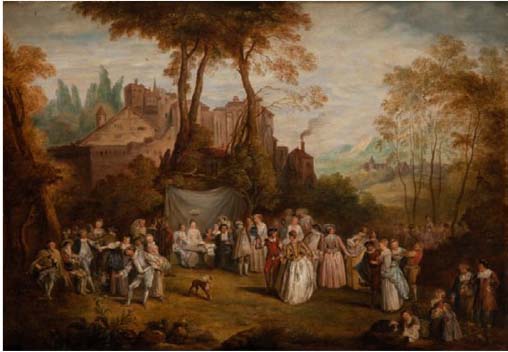
Whereabouts unknown
Oil on canvas
52 x 73 cm
PROVENANCE
Paris, Hôtel Drouot (Gros & Delettrez), December 21, 2012, lot 45: “Ecole FRANÇAISE du XIXème siècle, d’après WATTEAU. . . : L’accordée de village et le Cortège de la mariée / Paire de toiles / 52 x 73 cm / Cadre en bois sculpté et doré de style Louis XV / 5 000 / 7 000€." Sold for €12,000 the pair.
REMARKS
This picture and its pendant, a copy of La Mariée de village, are by admission nineteenth-century copies, made after the respective prints in the Jullienne Oeuvre gravé.
L'Accordée de village (copy 17)
Entered March 2014; revised September 2016
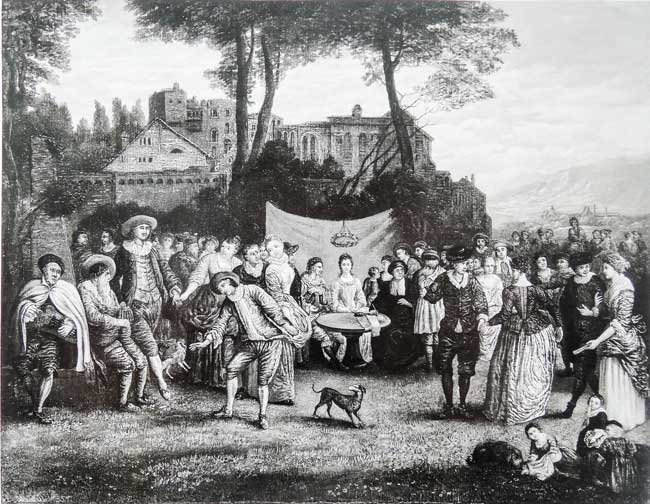
Whereabouts unknown
Oil on canvas
65 x 87 cm
PROVENANCE
Rome, collection Prince Emanuele Massimo Brancforte
REMARKS
This picture is known to me only through a photograph on file at the Service de documentation, Département des peintures, musée du Louvre. It copies the direction of Watteau’s original painting but is of poor quality.
L’Accordée de village (copy 18)
Entered November 2014
Whereabouts unknown
Oil on canvas
65.5 x 98 cm
PROVENANCE
Würzburg, with Albrecht Neuhaus (1936-2013; dealer); sold at TEFAF Maastricht in 2001 to Dr. Peter D. Sommer.
London, collection of Dr. Peter D. Sommer (1940-2013; professor of economics and political science). His sale, London, Christie’s, December 4, 2014, lot 5: “FOLLOWER OF JEAN-ANTOINE WATTEAU / L’Accordée de village/ oil on canvas / 25¾ x 38½ in. (65.5 x 98 cm) / £10,000-15,000 $17,000-24,000 / €13,000-19,000 / PROVENANCE: with Albrecht Neuhaus when purchased in 2001 at TEFAF Maastricht by the present owner / The present composition relates closely to Watteau’s painting of the same subject in the Soane Museum, London.” Sold for £20,000.
REMARKS
Although this work is almost to the scale of the original painting by Watteau, its direction indicates that the copyist was working from the Larmessin engraving of the composition.
L’Accordée de village (copy 19)
Entered December 2018; revised May 2021
Whereabouts unknown
Oil on canvas
19 x 24 cm
ALTERNATIVE TITLES
Young Children Gathering Flowers
PROVENANCE
Oakland, California, Clars Auction Gallery, February 17, 2018, lot 7236: "Painting. Attributed to Jean Antoine Watteau . . .Young Children Gathering Flowers, oil on canvas, bears artist’s name verso, 7.5”h x 9.5”w, overall (with frame): 11.5”h x 13.25”w." Sold for $1,700.
Oakland, California, Clars Auction Gallery, November 18, 2018, lot 6162: "Painting. Attributed to Jean Antoine Watteau . . .Young Children Gathering Flowers, oil on canvas, bears artist’s name verso, 7.5”h x 9.5”w, overall (with frame): 11.5”h x 13.25”w."
Oakland, California, Clars Auction Gallery, December 16, 2018, lot 7236: "Painting. Attributed to Jean Antoine Watteau . . .Young Children Gathering Flowers, oil on canvas, bears artist’s name verso, 7.5”h x 9.5”w, overall (with frame): 11.5”h x 13.25”w."
REMARKS
Despite the ambitious attribution to Watteau himself, this painting is merely a copy after the right hand side of the Larmessin engraving after Watteau’s L’Accordée de village. Moreover, its dark tonality and fuzzy quality suggest that it is not eighteenth century in origin.
The artist’s name on the verso is merely a recent penciled or penned attribution on the frame: “JEAN ANTOINE WATTEAU (1684-1721) / c. 1700.”
L’Accordée de village (copy 20)
Entered June 2019
Whereabouts unknown
Oil on canvas
85 x 140 cm
PROVENANCE
Namur, Belgium, Salle de Ventes Rops, June 16, 2019, lot 1747: “Huile our toile, entourage de Watteau (un coup) 85 x 140cm. / 6.000 euros / 8.000 euros.”
REMARKS
This picture is based upon the Larmessin engraving and though it faithfully repeats most of the principal figures, it omits the children and two adults in the lower right of the composition as well as the procession of figures entering from the distance. It imitates Watteau’s landscape in only a general way and, most important, the adjustments in proportions have changed the composition into a more horizontal format.
L’Accordée de village (copy 21)
Entered July 2019

Whereabouts unknown
Medium unknown
Measurements unknown
ALTERNATIVE TITLES
Le Contrat
PROVENANCE
Paris, sale, Hôtel des ventes mobilières, March 21-22, 1845, lot 37: “WATTEAU . . . (Attribué à) . . . Le Contrat; riche composition.
Paris, sale, Hôtel des ventes mobilières, May 8-10, 1845, lot 164: “WATTEAU (Attribué à). Le Contrat. Riche composition du maître.
REMARKS
The closeness in date of these two 1845 sales and the almost identical description for both make it likely that they refer to the same painting. Although labeled “Le Contrat,” it seems likely that the reference is to L’Accordée de village, a painting which does show a scene of signing a marriage contract, and was well-known and easily accessible. While the closely related painting in the Prado is normally called “Le Contrat,” that painting was fairly obscure in the mid-nineteenth century.
L’Accordée de village (copy 22)
Entered November 2019; revised May 2021
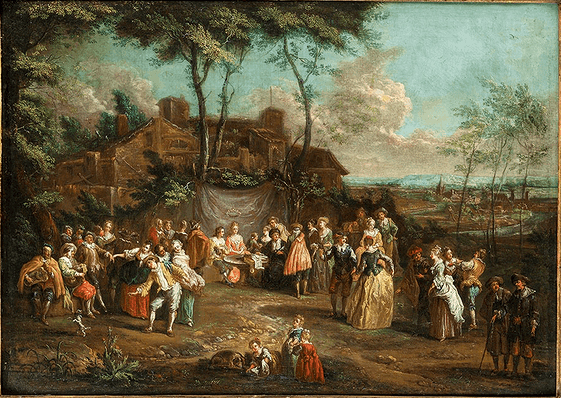
Whereabouts unknown
Oil on canvas
46 x 63.5 cm or 65.5 x 98 cm
ALTERNATIVE TITLES
Der Ehevertrag
PROVENANCE
Würzburg, Albrecht Neuhaus Kunsthandlung; sold in 2001 at TEFAF, Maastricht, to Dr. Peter D. Sommer.
London, collection of Dr. Peter D. Sommer. His sale, London, Christie’s, December 4, 2014, lot 5: Follower of Jean-Antoine Watteau, L’Accordée de village, oil on canvas, 25 ¾ x 38 ½ in (65.5 x 98 cm.) The present composition relates closely to Watteau’s painting of the same subject in the Soane Museum, London est. 10,000 – 15,000 GBP (15,705 -23,558 USD).
Munich, sale, Hampel, September 9, 2019, lot 678: “Franz Christoph Janneck . . .DER EHEVERTRAG / Öl auf Leinwand. Doubliert. 46 x 63.5 cm. In prunkvollem vergoldeten Rahmen. € 8.00 -12.00 / In weiter bergiger Landschaft, vor einem großen Gebäudekomplex, zwischen zwei Bäumen sitzend, vor einem grauen aufgehängten Tuch, das junge Brautpaar an einem runden Tisch. An diesem ebenfalls ein schwarz gekleideter Notar, der ein großes Buch und einige Schriften vor sich Liegend hat, in seiner Linken eine Feder haltend und damit einen Mann in Rückenansicht zum Unterzeichnen auffordernd. Über der in rötlichem Kleid sitzenden jungen Frau hängt ein Blumenkranz an der Decke, der sie als Braut auszeichnet. Umgeben sind sie von einer Vielzahl von Figuren: Auf der linken Bildseite zwei Musikanten an einem Baum sitzend und zwei Paare beim Tanz. Ein junger Mann mit gelber jacke scheint ein kleines weißes Hündchen zu dressieren. Auf der rechten Seite weitere Paare, davon eines zum Tanz ansetzend. Im Vordergrund drei kleine Kinder, die mit einem Hund spielen. Vielfigurige Darstellung dieses Ehevertrages in frischer Farbgebung, bei der die Kleider der Dargestellten oft in feinster Malweise wiedergegeben werden.”
REMARKS
This copy after the Larmessin engraving of Watteau’s L’Accordée de Village is relatively faithful but there are several deviations. For example, the three children now at the center of the composition were originally arranged to be seen against the men in the foreground corner.
Despite the considerable difference in measurements recorded in 2014 and 2019, photographs affirm that it is one and the same painting. The recent attribution of this copy to Franz Christoph Janneck (1703-1761) is doubtful, an attribution made without reference to the fact that the original composition was by Watteau.
L’Accordée de village (copy 23)
Entered March 2021
Whereabouts unknown
Oil on canvas
68.6 x 94 cm
PROVENANCE
St. Louis, Missouri, Link Auction Galleries, March 27, 2021, lot 62: Follower of Jean-Antoine Watteau . . . L’Accordée de Village, oil on canvas / an early copy from the original in the collection of Sir John Soane’s Museum of London, gilt frame, 27 x 37 inches. Est. $2,000 - $4,000
REMARKS
As best as can be told from a very poor image, this painting is a relatively accurate repetition of the figurative portion of the Larmessin engraving after Watteau’s L’Accordée de village. On the other hand, the landscape is wholly the copyist’s invention. The picture is almost as large as Watteau’s original canvas.
Click here for of L’Accordée de village
